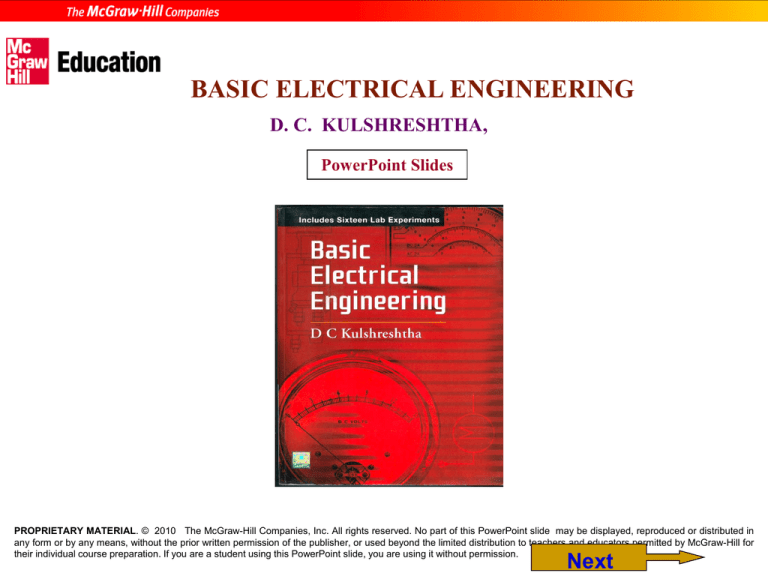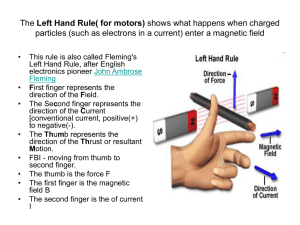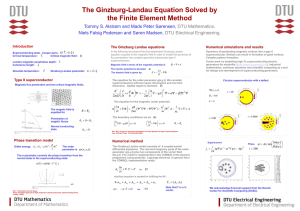
BASIC ELECTRICAL ENGINEERING
D. C. KULSHRESHTHA,
PowerPoint Slides
PROPRIETARY MATERIAL. © 2010 The McGraw-Hill Companies, Inc. All rights reserved. No part of this PowerPoint slide may be displayed, reproduced or distributed in
any form or by any means, without the prior written permission of the publisher, or used beyond the limited distribution to teachers and educators permitted by McGraw-Hill for
their individual course preparation. If you are a student using this PowerPoint slide, you are using it without permission.
Next
Chapter 6
Magnetic Circuits
D.C. Kulshreshtha
Next
Thought of the DAY
There are no secrets to success.
It is the result of
preparation, hard work,
and learning from
failure.
--Colin Powell..
Monday, April 13, 2015
Ch. 6 Magnetic Circuits
Next
3
Topics to be Discussed
Magnetomotive Force (MMF).
Magnetic Field Strength (H).
Magnetic Permeability.
Reluctance (R).
Analogy between Electric and Magnetic
Circuits.
Composite Magnetic Circuit.
Monday, April 13, 2015
Ch. 6 Magnetic Circuits
Next
4
Introduction
Unlike electric field lines, the lines of magnetic
flux form closed loops.
A magnetic circuit is a closed path followed by
lines of magnetic flux.
A copper wire, because of its high conductivity,
confines the electric current within itself.
Similarly, a ferromagnetic material (such as iron
or steel), due to its high permeability, confines
magnetic flux within itself.
Monday, April 13, 2015
Ch. 6 Magnetic Circuits
Next
5
Magnetomotive Force (MMF)
The electric current is due to the existence of an
electromotive force (emf).
By analogy, we may say that in a magnetic circuit, the
magnetic flux is due to the existence of a
magnetomotive force (mmf).
mmf is caused by a current flowing through one or more
turns.
The value of the mmf is proportional to the current and
the number of turns.
It is expressed in ampere turns (At).
But for the purpose of dimensional analysis, it is
expressed in amperes.
Monday, April 13, 2015
Ch. 6 Magnetic Circuits
Next
6
Magnetic Field Strength (H)
The mmf per metre length of the magnetic circuit
is termed as the magnetic field strength,
magnetic field intensity, or magnetizing force.
It units are ampere-turns per metre (At/m) .
Its value is independent of the medium .
F IN
H
l
l
Monday, April 13, 2015
Ch. 6 Magnetic Circuits
Next
7
Magnetic Permeability (μ)
If the core of the toroid is vacuum or air, the
magnetic flux density B in the core bears a
definite ratio to the magnetic field strength H.
This ratio is called permeability of free space.
Thus, for vacuum or air,
B
7
0 4 10 Tm/A
H
Monday, April 13, 2015
Ch. 6 Magnetic Circuits
Next
8
The flux produced by the given mmf is greatly
increased, if iron replaces the air in the core.
As a result, the flux density B also increases
many times.
In general, we can write B = μH.
μ is called the permeability of the material.
Normally, we write μ = μr μ0.
μr is called relative permeability (just a number).
Monday, April 13, 2015
Ch. 6 Magnetic Circuits
Next
9
Reluctance (R) and Permeance (G)
The current in an electric circuit is limited by the
presence of resistance of the electric circuit.
Similarly, the flux Φ in a magnetic circuit is
limited by the presence of the reluctance of the
magnetic circuit,
1 l
1 l
R
A r 0 A
The reciprocal of reluctance is known as
permeance (G).
Monday, April 13, 2015
Ch. 6 Magnetic Circuits
Next
10
Magnetic Circuit Theory
For a toroid, mmf, F = NI ampere-turns.
Because of this mmf, a magnetic field of strength
H is set up throughout the length l.
Therefore, F = Hl
If, B is the flux density, total flux is given as
Φ=BA
Dividing, we get
Click
F
Φ BA B A
A
A
r 0
Φ
l /(r 0 A)
F
Hl H l
l
l
Monday, April 13, 2015
Ch. 6 Magnetic Circuits
Next
11
E
I
R
Comparing this with
1
l
We get R
r 0 A
Monday, April 13, 2015
Ch. 6 Magnetic Circuits
Next
12
Analogy between Electric and Magnetic Circuits
Monday, April 13, 2015
Ch. 6 Magnetic Circuits
Next
13
Example 1
Calculate the magnetomotive force (mmf)
required to produce a flux of 0.015 Wb across
an air gap of 2.5 mm long, having an effective
area of 200 cm2.
Solution :
Φ
0.015
B
0.75 T
4
A 200 10
B
0.75
H
597000 A/m
-7
0 4π 10
F Hl 597000 2.5 103 1492 At
Monday, April 13, 2015
Ch. 6 Magnetic Circuits
Next
14
Composite Magnetic Circuit
Case 1 :
l1
R1
1 A1
l2
R2
2 A2
l1
l2
T otalReluctance, R R 1 R 2
1 A1 2 A2
Monday, April 13, 2015
Ch. 6 Magnetic Circuits
Next
15
mmf of coil
T ot alflux,
t ot alreluct ance
F
NI
l1
l2
R
1 A1 2 A2
Monday, April 13, 2015
Ch. 6 Magnetic Circuits
Next
16
Case 2 : (with air gap)
Total reluctance,
l1
l2
R
1 A 0 A
1
l1
l2
0 A ( 1 / 0 )
1 l1
l2
0 A r
Monday, April 13, 2015
Ch. 6 Magnetic Circuits
Next
17
Since the relative permeability μr (= μ1/ μ0) of
steel is very large (of the order of thousand), the
major contribution in the total reluctance R is by
the air-gap, though its length l2 may be quite
small (say, a few millimetres).
Monday, April 13, 2015
Ch. 6 Magnetic Circuits
Next
18
Kirchhoff’s Laws
Kirchhoff’s Flux Law (KFL) : The total
magnetic flux towards a junction is equal to the
total magnetic flux away from that junction.
Kirchhoff’s Magnetomotive Force Law
(KML) : In a closed magnetic circuit, the
algebraic sum of the product of the magnetic
field strength and the length of each part of the
circuit is equal to the resultant magnetomotive
force.
Monday, April 13, 2015
Ch. 6 Magnetic Circuits
Next
19
Steps to solve a problem on magnetic circuit
Monday, April 13, 2015
Ch. 6 Magnetic Circuits
Next
20
Review
Magnetomotive Force (MMF).
Magnetic Field Strength (H).
Magnetic Permeability.
Reluctance (R).
Analogy between Electric and Magnetic
Circuits.
Composite Magnetic Circuit.
Monday, April 13, 2015
Ch. 6 Magnetic Circuits
Next
21








